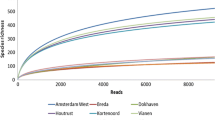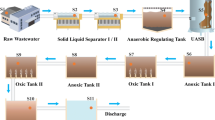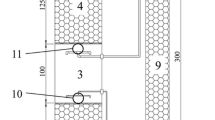Abstract
The ammonia oxidizing bacteria (AOB) community structure in a municipal wastewater treatment plant (WWTP) was monitored over the winter and summer periods. The AOB distribution in the full-scale WWTP was investigated using barcoded 454-pyrosequencing targeting the ammonia monooxygenase alpha subunit (amoA) gene. Using the quantitative polymerase chain reaction (qPCR) technique, the AOB population was quantified over 237 days. The plant operational parameters and its nitrification performance were also monitored. As revealed by pyrosequencing, majority of the identified AOB during the study were related to uncultured ammonia oxidizing bacteria, and Nitrosomonas oligotropha. Furthermore, it revealed higher AOB abundance during the summer which was 6 times more compared to winter. Substantial percentages of the reads from both seasons could not be assigned to any phylum, which suggests that vast population of novel, ecologically significant AOB species still inhabit the complex activated sludge communities unexploited. A significant seasonal variation in temperature (α = 0.05; P = < 0.0001) was recorded in the reactor with maximum temperature amplitude of 10.2 °C. The average nitrification rate recorded during the summer was 0.09 ± 0.03 g N-NH4+/g MLSS/d, whereas it was 0.04 ± 0.02 g N-NH4+/g MLSS/d during the winter. The nitrification rate of the plant had significant correlation with AOB population abundance (r = 0.70; P = 0.01) and temperature (α = 0.05; P = 0.0018). This study indicates that AOB diversity and population abundance were contributory factors to efficient nitrification in activated sludge system.






Similar content being viewed by others
References
Abe T, Ushiki N, Fujitani H, Tsuneda S (2017) A rapid collection of yet unknown ammonia oxidizers in pure culture from activated sludge. Water Res 108:169–178
APHA (1998) Standard methods for the examination of water and wastewater, 20th edn. American Public Health Association
Arévalo J, Ruiz LM, Pérez J, Gómez MA (2014) Effect of temperature on membrane bioreactor performance working with high hydraulic and sludge retention time. Biochem Eng J 88:42–49. https://doi.org/10.1016/j.bej.2014.03.006
Awolusi OO (2016) Evaluation of seasonal impacts on nitrifiers and nitrification performance of a full-scale activated sludge system. Doctoral dissertation, Durban University of Technology
Awolusi OO, Kumari SKS, Bux F (2015) Ecophysiology of nitrifying communities in membrane bioreactors. Int J Environ Sci Technol 12:747–762. https://doi.org/10.1007/s13762-014-0551-x
Awolusi OO, Nasr M, Kumari S, Bux F (2016) Artificial intelligence for the evaluation of operational parameters influencing nitrification and nitrifiers in an activated sludge process. Microb Ecol 72:49–63
Aydin S, Ince B, Ince O (2015) Application of real-time PCR to determination of combined effect of antibiotics on bacteria, methanogenic archaea, archaea in anaerobic sequencing batch reactors. Water Res 76:88–98. https://doi.org/10.1016/j.watres.2015.02.043
Briese V (2002) DNA precipitation. http://www.protocol-online.org/cgi-bin/prot/view_cache.cgi?ID=2744. Accessed 9/15/ 2012
Degrange V, Bardin R (1995) Detection and counting of Nitrobacter populations in soil by PCR. Appl Environ Microbiol 61:2093–2098
Faulwetter JL, Burr MD, Parker AE, Stein OR, Camper AK (2013) Influence of season and plant species on the abundance and diversity of sulfate reducing bacteria and ammonia oxidizing bacteria in constructed wetland microcosms. Microb Ecol 65:111–127. https://doi.org/10.1007/s00248-012-0114-y
Fitzgerald CM, Camejo P, Oshlag JZ, Noguera DR (2015) Ammonia-oxidizing microbial communities in reactors with efficient nitrification at low-dissolved oxygen. Water Res 70:38–51. https://doi.org/10.1016/j.watres.2014.11.041
Fulweiler RW, Emery HE, HE M, Berounsky VM (2011) Assessing the role of pH in determining water column nitrification rates in a coastal system. Estuar Coasts 34:1095–1102
Gomez-Silvan C, Molina-Munoz M, Poyatos JM, Ramos A, Hontoria E, Rodelas B, Gonzalez-Lopez J (2010) Structure of archaeal communities in membrane-bioreactor and submerged-biofilter wastewater treatment plants. Bioresour Technol 101:2096–2105. https://doi.org/10.1016/j.biortech.2009.10.091
Harms G, Layton AC, Dionisi HM, Gregory IR, Garrett VM, Hawkins SA, Robinson KG, Sayler GS (2003) Real-time PCR quantification of nitrifying bacteria in a municipal wastewater treatment plant. Environ Sci Technol 37:343–351
Ju F, Zhang T (2015a) 16S rRNA gene high-throughput sequencing data mining of microbial diversity and interactions. Appl Microbiol Biotechnol 99:4119–4129. https://doi.org/10.1007/s00253-015-6536-y
Ju F, Zhang T (2015b) Bacterial assembly and temporal dynamics in activated sludge of a full-scale municipal wastewater treatment plant. ISME J 9:683–695. https://doi.org/10.1038/ismej.2014.162
Ju F, Guo F, Ye L, Xia Y, Zhang T (2014) Metagenomic analysis on seasonal microbial variations of activated sludge from a full-scale wastewater treatment plant over 4 years. Environ Microbiol 6:80–89. https://doi.org/10.1111/1758-2229.12110
Keuter S, Beth S, Quantz G, Schulz C, Spieck E (2017) Longterm monitoring of nitrification and nitrifying communities during biofilter activation of two marine recirculation aquaculture systems (RAS). Int J Aquac Fish Sci 3:051–061. https://doi.org/10.17352/2455-8400.000029
Kim YM (2013) Acclimatization of communities of ammonia oxidizing bacteria to seasonal changes in optimal conditions in a coke wastewater treatment plant. Bioresour Technol 147:627–631. https://doi.org/10.1016/j.biortech.2013.08.062
Kim J, Guo X, Park H (2008) Comparison study of the effects of temperature and free ammonia concentration on nitrifiers and nitrite accumulation. Process Biochem 43:154–160. https://doi.org/10.1016/j.procbio.2007.11.005
Kim YM, Cho HU, Lee DS, Park D, Park JM (2011) Influence of operational parameters on nitrogen removal efficiency and microbial communities in a full-scale activated sludge process. Water Res 45:5785–5795. https://doi.org/10.1016/j.watres.2011.08.063
Kim J, Lim J, Lee C (2013) Quantitative real-time PCR approaches for microbial community studies in wastewater treatment systems: applications and considerations. Biotechnol Adv 31:1358–1373. https://doi.org/10.1016/j.biotechadv.2013.05.010
Klindworth A, Pruesse E, Schweer T, Peplies J, Quast C, Horn M, Glockner FO (2013) Evaluation of general 16S ribosomal RNA gene PCR primers for classical and next-generation sequencing-based diversity studies. Nucleic Acids Res 41:e1. https://doi.org/10.1093/nar/gks808
LaPara TM, Ghosh S (2006) Population dynamics of the ammonia-oxidizing bacteria in a full-scale municipal wastewater treatment facility. Environ Eng Sci 23:309–319
Lienen T, Kleybocker A, Verstraete W, Wurdemann H (2014) Moderate temperature increase leads to disintegration of floating sludge and lower abundance of the filamentous bacterium Microthrix parvicella in anaerobic digesters. Water Res 65:203–212. https://doi.org/10.1016/j.watres.2014.07.019
Liu G, Wang J (2013) Long-term low DO enriches and shifts nitrifier community in activated sludge. Environ Sci Technol 47:5109–5117. https://doi.org/10.1021/es304647y
McMahon KD, Gu AZ, Nerenberg R, Sturm BM (2009) Molecular methods in biological systems. Water Environ Res 81:986–1002. https://doi.org/10.2175/106143009X12445568399370
McTavish HJAF, Fuchs JA, Hooper AB (1993) Sequence of the gene coding for ammonia monooxygenase in Nitrosomonas europaea. J Bacteriol 175:2436–2444
Miura Y, Hiraiwa MN, Ito T, Itonaga T, Watanabe Y, Okabe S (2007) Bacterial community structures in MBRs treating municipal wastewater: relationship between community stability and reactor performance. Water Res 41:627–637. https://doi.org/10.1016/j.watres.2006.11.005
Morozova O, Marra MA (2008) Applications of next-generation sequencing technologies in functional genomics. Genomics 92:255–264. https://doi.org/10.1016/j.ygeno.2008.07.001
Mousavi SA, Ibrahim S, Aroua MK (2017) Effect of carbon source on acclimatization of nitrifying bacteria to achieve high-rate partial nitrification of wastewater with high ammonium concentration. Appl Water Sci 7:165–173. https://doi.org/10.1007/s13201-014-0229-z
Niu J, Kasuga I, Kurisu F, Furumai H, Shigeeda T, Takahashi K (2016) Abundance and diversity of ammonia-oxidizing archaea and bacteria on granular activated carbon and their fates during drinking water purification process. Appl Microbiol Biotechnol 100:729–742. https://doi.org/10.1007/s00253-015-6969-3
Park HD, Noguera DR (2004) Evaluating the effect of dissolved oxygen on ammonia-oxidizing bacterial communities in activated sludge. Water Res 38:3275–3286
Ramond JB, Lako JDW, Stafford WHL, Tuffin MI, Cowan DA (2015) Evidence of novel plant-species specific ammonia oxidizing bacterial clades in acidic South African fynbos soils J Basic Microbiol: https://doi.org/10.1002/jobm.201400933
Rowan AK, Snape JR, Fearnside D, Barer MR, Curtis TP, Head IM (2003) Composition and diversity of ammonia-oxidising bacterial communities in wastewater treatment reactors of different design treating identical wastewater. FEMS Microbiol Ecol 43:195–206
Ruiz G, Jeison D, Chamy R (2003) Nitrification with high nitrite accumulation for the treatment of wastewater with high ammonia concentration. Water Res 37:1371–1377
Sajuni NR, Ahmad AL, Vadivelu VM (2010) Effect of filter media characteristics, pH and temperature on the ammonia removal in the wastewater. J Appl Sci 10:1146–1150
Schloss PD, Westcott SL, Ryabin T, Hall JR, Hartmann M, Hollister EB, Lesniewski RA, Oakley BB, Parks DH, Robinson CJ, Sahl JW, Stres B, Thallinger GG, van Horn DJ, Weber CF (2009) Introducing mothur: open-source, platform-independent, community-supported software for describing and comparing microbial communities. Appl Environ Microbiol 75:7537–7541
Sekar S, Zintchem AAEA, Keshri J, Kamika I, Momba MNB (2014) Bacterial profiling in brine samples of the Emalahleni water reclamation plant, South Africa, using 454-pyrosequencing method. FEMS Microbiol Lett 359:1–9. https://doi.org/10.1111/1574-6968.12557
Shi P, Jia S, Zhang XX, Zhang T, Cheng S, Li A (2013) Metagenomic insights into chlorination effects on microbial antibiotic resistance in drinking water. Water Res 47:111–120. https://doi.org/10.1016/j.watres.2012.09.046
Shokralla S, Spall JL, Gibson JF, Hajibabaei M (2012) Next-generation sequencing technologies for environmental DNA research. Mol Ecol 21:1794–1805. https://doi.org/10.1111/j.1365-294X.2012.05538.x
Siripong S, Rittmann BE (2007) Diversity study of nitrifying bacteria in full-scale municipal wastewater treatment plants. Water Res 41:1110–1120. https://doi.org/10.1016/j.watres.2006.11.050
Steinberg LM, Regan JM (2009) mcrA-targeted real-time quantitative PCR method to examine methanogen communities. Appl Environ Microbiol 75:4435–4442. https://doi.org/10.1128/AEM.02858-08
Tamura K, Stecher G, Peterson D, Filipski A, Kumar S (2013) MEGA6: molecular evolutionary genetics analysis version 6.0 Mol Biol Evol 30:2725–2729
Tvrdik D, Stanek L, Skalova H, Dundr P, Velenska Z, Povysil C (2012) Comparison of the IHC, FISH, SISH and qPCR methods for the molecular diagnosis of breast cancer. Mol Med Rep 6:439–443. https://doi.org/10.3892/mmr.2012.919
Urakawa H, Tajima Y, Numata Y, Tsuneda S (2008) Low temperature decreases the phylogenetic diversity of ammonia-oxidizing archaea and bacteria in aquarium biofiltration systems. Appl Environ Microbiol 74:894–900
Wang X, Wen X, Criddle C, Wells G, Zhang J, Zhao Y (2010) Community analysis of ammonia-oxidizing bacteria in activated sludge of eight wastewater treatment systems. J Environ Sci 22:627–634
Xia S, Duan L, Song Y, Li J, Piceno YM, Andersen GL, Alvarez-Cohen L, Moreno-Andrade I, Huang CL, Hermanowicz SW (2010) Bacterial community structure in geographically distributed biological wastewater treatment reactors. Environ Sci Technol 44:7391–7396
Yan J, Hu YY (2009) Partial nitrification to nitrite for treating ammonium-rich organic wastewater by immobilized biomass system. Bioresour Technol 100:2341–2347. https://doi.org/10.1016/j.biortech.2008.11.038
Yang C, Zhang W, Liu R, Li Q, Li B, Wang S, Song C, Qiao C, Mulchandani A (2011) Phylogenetic diversity and metabolic potential of activated sludge microbial communities in full-scale wastewater treatment plants. Environ Sci Technol 45:7408–7415. https://doi.org/10.1021/es2010545
Zhang B, Sun B, Ji M, Liu H (2009) Population dynamic succession and quantification of ammonia-oxidizing bacteria in a membrane bioreactor treating municipal wastewater. J Hazard Mater 165:796–803. https://doi.org/10.1016/j.jhazmat.2008.10.116
Zhang Y, Chen L, Sun R, Dai T, Tian J, Wen D (2015) Ammonia-oxidizing bacteria and archaea in wastewater treatment plant sludge and nearby coastal sediment in an industrial area in China. Appl Microbiol Biotechnol 99:4495–4507. https://doi.org/10.1007/s00253-014-6352-9
Zheng Y, Hou L, Liu M, Lu M, Zhao H, Yin G, Zhou J (2013) Diversity, abundance, and activity of ammonia-oxidizing bacteria and archaea in Chongming eastern intertidal sediments. Appl Microbiol Biotechnol 97:8351–8363
Acknowledgements
This work was supported financially by Durban University of Technology and the National Research Foundation SARChI Chair. An initial shorter version of the paper has been presented at the 10th World Congress of the European Water Resources Association (EWRA2017) “Panta Rhei”, Athens, Greece, 5-9 July, 2017 624 (http://ewra2017.ewra.net/).
Author information
Authors and Affiliations
Corresponding author
Ethics declarations
Conflict of Interest
The authors declare that they have no conflicts of interest.
Rights and permissions
About this article
Cite this article
Awolusi, O., Kumari, S. & Bux, F. Evaluation of Ammonia Oxidizing Bacterial Community Structure of a Municipal Activated Sludge Plant by 454 High-Throughput Pyrosequencing. Environ. Process. 5 (Suppl 1), 43–57 (2018). https://doi.org/10.1007/s40710-018-0319-2
Received:
Accepted:
Published:
Issue Date:
DOI: https://doi.org/10.1007/s40710-018-0319-2




